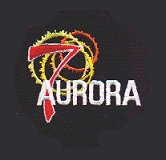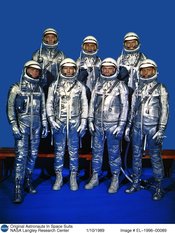Mercury Atlas 7
|
|
- Alternate meaning: Mercury Seven
| Mission Insignia | |
|---|---|

| |
| Mission Statistics | |
| Mission Name: | Mercury MA-7 |
| Call Sign: | Aurora 7 |
| Number of Crew Members: | 1 |
| Launch: | May 24, 1962 12:45:16 UTC Cape Canaveral Complex 14 |
| Landing: | May 24, 1962 17:41:00 UTC Template:Coor dm |
| Duration: | 4 h 56 min 15 s |
| Number of Orbits: | 3 |
| Distance Traveled: | 76,021 mi 122,344 km |
| Maximum velocity: | 17,549 mph 28,242 km/h |
| Peak acceleration: | 7.8 g (76 m/s²) |
| Mass: | 1,350 kg |
| Crew Picture | |
| Scott Carpenter | |
Missing image Mercury_8_launch.jpg MA-7 launch preparation (NASA) |
| Contents |
Crew
- Scott Carpenter (flew on Mercury 7)
The original prime crew for Mercury Atlas-7 was Deke Slayton, however Slayton was controversially removed from all flight crew availability after the discovery of cardiac arrhythmia during a training run in the g-loading centrifuge.
Backup Crew
Mission Parameters
- Mass: 2975 lb (1350 kg)
- Perigee: 154 km
- Apogee: 260 km
- Inclination: 32.5°
- Period: 88.3 min
See also
Mission Highlights
Mercury 7 was a Mercury program American manned space mission launched May 24, 1962. The Mercury capsule was named "Aurora 7" and made three earth orbits, piloted by astronaut Scott Carpenter. A targeting mishap during reentry took the spacecraft 250 miles (about 400 km) off course, delaying recovery of Carpenter and the craft. The mission used Mercury spacecraft #18 and Atlas #107-D.
Mercury spacecraft #18 was delivered to Cape Canaveral on November 15, 1961. Atlas #107-D was rolled out of the Convair factory in San Diego, CA on February 25, 1962. It was delivered to Cape Canaveral, FL on March 6, 1962.
Mercury spacecraft #18 — Aurora 7, used in the Mercury-Atlas 7 mission, is currently displayed at the United States Astronaut Hall of Fame, Titusville, Florida. Mercury spacecraft #18 Aurora 7 display page on A Field Guide to American Spacecraft website. (http://aesp.nasa.okstate.edu/fieldguide/pages/mercury/ma-7.html)
The focus of Carpenter's five-hour Aurora 7 mission was on science. The full flight plan included the first study of liquids in weightlessness, Earth photography and an unsuccessful attempt to observe a flare fired from the ground. At dawn of the third and final orbit, Carpenter inadvertently bumped his hand against the inside wall of the cabin and solved a mystery from the previous flight. The resulting bright shower of particles outside the capsule-what Glenn had called "fireflies"-turned out to be ice particles shaken loose from the capsule's exterior. Like Glenn, Carpenter circled the Earth three times.
Total time weightless 4 h 39 min 32 s. The performance of the Mercury spacecraft and Atlas launch vehicle was excellent in nearly every respect. All primary mission objectives were achieved. The single mission critical malfunction which occurred involved a failure in the spacecraft pitch horizon scanner, a component of the automatic control system. This anomaly was adequately compensated for by the pilot in subsequent in-flight operations so that the success of the mission was not compromised. A modification of the spacecraft control-system thrust units were effective. Cabin and pressure-suit temperatures were high but not intolerable. Some uncertainties in the data telemetered from the bioinstrumentation prevailed at times during the flight; however, associated information was available which indicated continued well-being of the astronaut. Equipment was included in the spacecraft which provided valuable scientific information; notably that regarding liquid behavior in a weightless state, identification of the airglow layer observed by Astronaut Glenn, and photography of terrestrial features and meteorological phenomena. An experiment which was to provide atmospheric drag and color visibility data in space through deployment of an inflatable sphere was partially successful. The flight further qualified the Mercury spacecraft systems for manned orbital operations and provided evidence for progressing into missions of extended duration and consequently more demanding systems requirements.
Partly because he had been distracted watching the fireflies and partly because of his busy schedule, and a malfunction of the automatic alignment system, he overshot his planned reentry mark, and splashed down 402 kilometers off target.
Mercury-Atlas Three Orbit Flight Events
| T+ Time | Event | Description |
|---|---|---|
| T+00:00:00 | Liftoff | Mercury-Atlas lifts off, onboard clock starts. |
| T+00:00:02 | Roll Program | Mercury-Atlas rotates along its axis 2.5 deg/s from 30° to 0°. |
| T+00:00:16 | Pitch Program | Mercury-Atlas begins a 0.5 deg/s pitch from 90° to 0°. |
| T+00:00:30 | Radio Guidance Lock | General Electric-Burroughs guidance system locks onto radio transponder in Atlas booster to guide the vehicle until orbit insertion. |
| T+00:01:24 | Max Q | Maximum dynamic pressure ~980 lbf/ft² (47 kPa) |
| T+00:02:10 | BECO | Atlas Booster Engine Cutoff. Booster engines drop away. |
| T+00:02:33 | Tower Jettison | Escape Tower Jettison, no longer needed. |
| T+00:02:25 | Atlas Pitchover | After tower separation, vehicle pitches over further. |
| T+00:05:20 | SECO | Atlas Sustainer Engine Cutoff, capsule reaches orbit, velocity 17,547 mph (7,844 m/s). |
| T+00:05:24 | Capsule Separation | Posigrade rockets fire for 1 second giving 15 ft/s (5 m/s) separation. |
| T+00:05:25 | 5-Second Rate Damping | ASCS damps capsule rates for 5 seconds in preparation for turnaround maneuver. |
| T+00:05:25 | Turnaround Maneuver | Capsule (ASCS) system rotates capsule 180 degrees, to heat shield forward attitude. Nose is pitched down 34 degrees to retro fire position. |
| T+00:05:30 T+04:30:00 | Orbital Operations | Orbital operations and experiments for 3 orbits. |
| T+04:30:00 | Retro Sequence Start | Retrofire in 30 s; (ASCS) checks for proper retro attitude −34° pitch, 0° yaw, 0° roll. |
| T+04:30:30 | Retrofire | Three retro rockets fire for 10 seconds each. They are started at 5 second intervals, firing overlaps for a total of 20 seconds. Delta V of 550 ft/s (168 m/s) is taken off forward velocity. |
| T+04:31:00 | Retract Periscope | Periscope is automatically retracted in preparation for reentry. |
| T+04:31:50 | Retro Pack Jettison | One minute after retrofire retro pack is jettisoned, leaving heatshield clear. |
| T+04:33:00 | Retro Attitude Maneuver | (ASCS) orients capsule in 34° nose down pitch, 0° roll, 0° yaw. |
| T+04:40:30 | .05 G Maneuver | (ASCS) detects beginning of reentry and rolls capsule at 10 degrees per second to stabilize capsule during reentry. |
| T+04:50:20 | Drogue Parachute Deploy | Drogue parachute deployed at 22,000 ft (6.7 km) slowing descent to 365 ft/s (111 m/s) and stabilizing capsule. |
| T+04:50:25 | Snorkel Deploy | Fresh air snorkel deploys at 20,000 ft (6 km) ECS switches to emergency oxygen rate to cool cabin. |
| T+04:51:55 | Main Parachute Deploy | Main parachute deploys at 10,000 ft (3 km). Descent rate slows to 30 ft/s (9 m/s). |
| T+04:52:00 | Landing Bag Deploy | Landing Bag Deploys, dropping heat shield down four feet (1.2 m). |
| T+04:52:30 | Fuel Dump | Remaining hydrogen peroxide fuel automatically dumped. |
| T+04:57:10 | Splashdown | Capsule lands in water. |
| T+04:57:10 | Rescue Aids Deploy | Rescue aid package deployed. The package includes green dye marker, recovery radio beacon and whip antenna. |
External links
- Results of the second u.s. manned orbital space flight (http://ntrs.nasa.gov/archive/nasa/casi.ntrs.nasa.gov/19620004691_1962004691.pdf), May 24, 1962 (Aurora 7) NASA report - (PDF format)
- This New Ocean: A History of Project Mercury - NASA report (PDF format) (http://ntrs.nasa.gov/archive/nasa/casi.ntrs.nasa.gov/19990026158_1999028570.pdf)
- Chronology of Project Mercury - NASA report (PDF format) (http://ntrs.nasa.gov/archive/nasa/casi.ntrs.nasa.gov/19630011968_1963011968.pdf)

